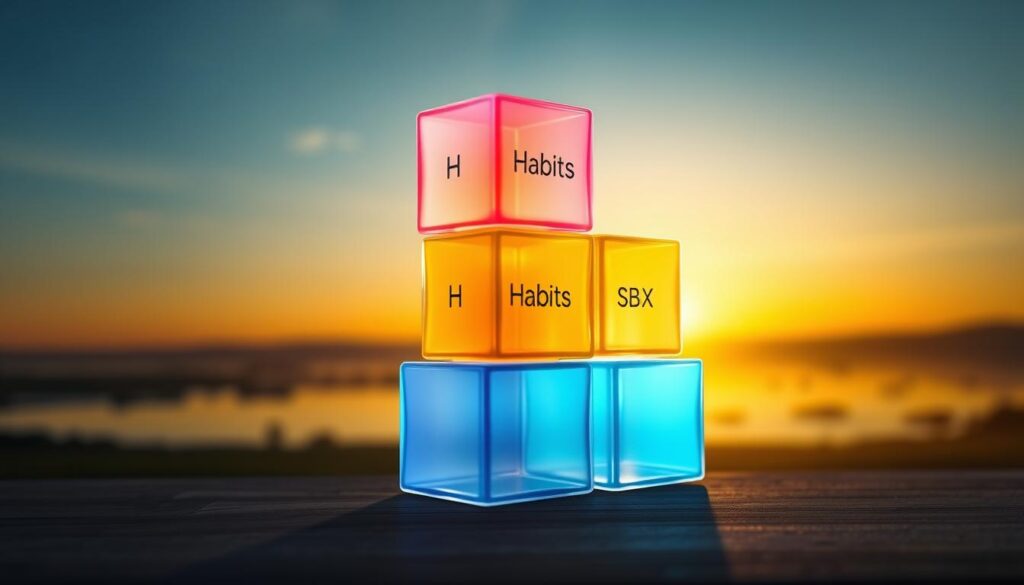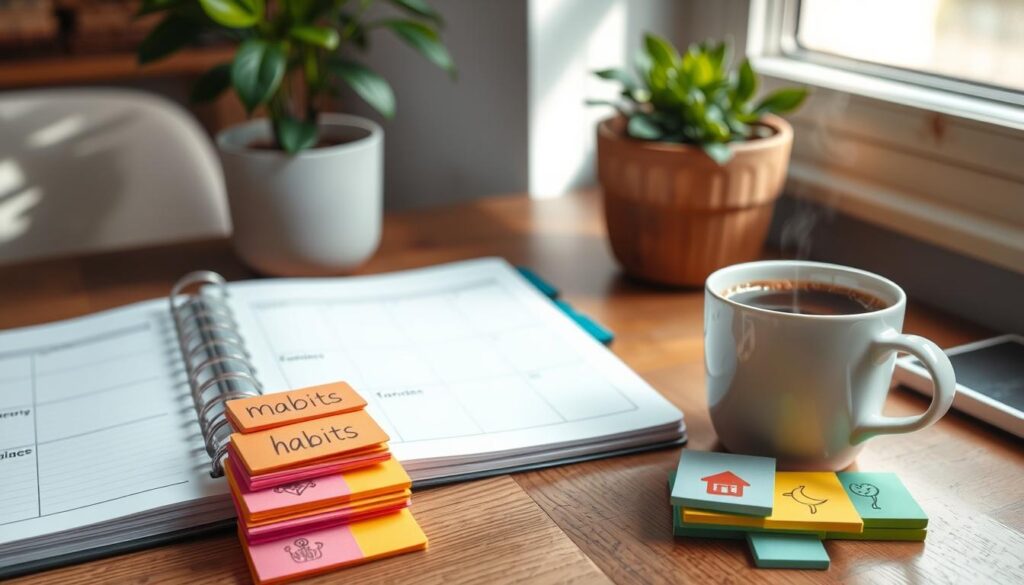Did you know that about half of what we do every day is habitual? This means it’s driven by repetition, not choice1. Imagine if we could make these habits work for us, not against us. Habit stacking, made famous by James Clear in “Atomic Habits,” changes how we think about our daily routines. It’s about linking small, good habits together, so they’re done all at once with just one trigger2.
This method makes starting new habits easier by linking them to habits we already do. It’s a simple way to boost productivity and make good habits stick without much effort.
Studies show it takes about 66 days to make a simple habit stick, with times ranging from 18 to 254 days3. Habit stacking makes this process faster, helping you be more productive with less effort. It’s especially useful at work, where staying productive can be a challenge. Habit stacking helps keep your performance steady by making daily high-performance habits a part of your routine2.
Key Takeaways
- Habit stacking groups small, beneficial habits into one sequence, requiring only a single trigger.
- It can significantly reduce the time and effort needed to adopt new habits, improving productivity2.
- Research indicates it takes an average of 66 days to solidify a simple habit3.
- Habit stacking helps maintain consistent productivity by establishing high-performance daily routines2.
- Half of daily actions are driven by repetition, highlighting the impact of well-structured habits1.
What is Habit Stacking?
Habit stacking is a method to add new habits to ones you already have. It was first talked about by James Clear in “Atomic Habits.” It makes starting new habits easier by linking them to habits you already do every day. This way, you can change your behavior by using your daily routines4.
Studies show that as we get older, our brains have fewer neurons. This makes it key to keep the connections between neurons strong. By saying “After/Before [CURRENT HABIT], I will [NEW HABIT],” you can add new habits to your daily life4. For example, “After brushing my teeth, I will meditate for five minutes.
BJ Fogg’s Tiny Habits program uses habit stacking to help people form new habits. It focuses on using specific triggers to make new habits clear4. By linking small habits together, you can create bigger sequences that help you stay motivated all day4.
Creating a new habit can take 18 to 200 days, showing how important it is to be consistent5. Adding new habits to ones you already do makes it more likely to succeed. But, how well it works depends on your personal preferences and the habit’s complexity5.
Being specific and clear about your habits is crucial for success. Vague goals like “read more” or “eat better” don’t work as well. Instead, choose specific actions, like “After dinner, I will read one article” or “Before bedtime, I will eat a piece of fruit”4. This makes it easier to stick to your habits.
How Habit Stacking Enhances Productivity
Habit stacking is a smart way to boost productivity. It links new habits to daily routines, making them automatic. This saves mental energy and makes tasks easier, improving efficiency.
Reducing Decision Fatigue
Habit stacking helps reduce decision fatigue. It saves mental energy by reducing choices. Simple habits like making the bed or brushing teeth fit easily into our day, saving mental effort6.
By adding new habits to old ones, we create smooth sequences of actions. This makes our day more efficient without the need to plan each step7.
Creating Seamless Routines
Seamless routines are key in habit stacking. One action can lead to another, creating a productive flow. For example, stretching while making coffee or thinking of things to be grateful for while brushing teeth7.
This method keeps distractions away and helps us stay focused on tasks. It makes our day more efficient.
Small, fun habits help build a productive life6. By aligning these habits, we create efficient routines that support our goals. This strengthens our brain’s connections through repeated actions7.
By reinforcing these neural paths, we improve control and productivity in life.
Building Positive Habits Through Stacking
Creating positive habits starts with a basic habit. Then, add new, good behaviors to it. This makes your daily routine better and more efficient.
Studies show habit stacking works well for new habits. It uses what you already do to remember new things. People who use this method stick to new habits 80% more than those who try hard on their own.
Bj Fogg, PhD from Stanford, talks about linking behaviors for lasting change8. People who stick to routines sleep better and feel less stressed. Habit stacking leads to 40% better health and well-being than big changes.
Setting a timeline for new habits helps you stay on track. Adding rewards makes you want to keep doing it. This makes it easier to keep up good habits8.
Brain connections are strongest for habits you already do. As we age, our brains get better at sticking to routines9. Simple habits like squats after brushing teeth or journaling with breakfast help a lot9. These small steps add up to big success over time8.
The Anatomy of a Habit Stack
Understanding a habit stack means knowing what starts the chain and what follows. At the core are the trigger habits, which kick off a series of actions. These stacks make our routines smoother, cutting down on the need for constant reminders10.
Identifying Triggers
Triggers are the first signs that start a habit stack in motion. James Clear says habits grow from repeated actions that become automatic10. We find these triggers in our daily routines. A morning coffee might start a quick exercise routine, leading to more positive actions.
Choosing Complementary Habits
Choosing habits that fit well with our existing ones is key to habit stacking. This way, we create routines that are both efficient and productive. The microcopy stacking method helps by linking new habits to ones we already do, making them easier to adopt11.
This approach shows how important it is to pick actions that naturally fit together. For example, teachers might use habit stacking in class. They link a new activity to a habit students already have, making learning more structured and effective10.
Examples of Effective Habit Stacks
Habit stacking boosts productivity and makes routines smooth. Here are some daily stack examples to try:
- Morning Routine: Begin with waking up, making your bed, and meditating for 15 minutes. Then, plan your day. This sets a positive start12.
- Work-Related Stack: Start your workday by turning on your computer and reviewing your to-do list. Then, sort your emails to stay focused12.
- Exercise Routine: Do squats during bathroom breaks or listen to audiobooks while doing chores. It’s a way to stay active and get things done1213.
- Mealtime Preparation: Prepare meals while listening to podcasts or doing breathwork. It makes the time more enjoyable and productive12.
- Evening Wind Down: Before bed, do skincare, talk about your day, and read for 15 minutes. It helps you relax and sleep better14.
- Weekend Planning: Use weekends to organize your week, shop for groceries, and plan meals. It saves time and energy12.
- Self-Care Routine: Use a red light therapy mask while journaling or practicing gratitude. It’s good for your body and mind12
These examples help you live a balanced and productive life. Each stack is about growing gradually and intentionally. For example, start with five minutes of meditation and increase it over time. This shows how small steps can lead to big results14.
Using Habit Stacking for Routine Building
Habit stacking is a great way to make your daily life smoother. It helps you add small habits to your morning and evening routines. This makes your day more consistent and fulfilling.
Morning Routine Suggestions
Starting your day with a good morning routine is key. Try combining exercise with your morning coffee. Then, add a short reading session during breakfast. This mix makes each activity better together.
Many people, one in four, are into habit stacking, as seen in The Peloton Report: Spring Wellness Trends15. It’s all about being consistent. A 2021 study showed it takes 59 days to form a new habit with daily effort16.
Evening Routine Ideas
Evening routines help you relax and get ready for tomorrow. Try journaling your day’s wins after dinner or meditate before bed. This boosts your mental health. Angela Ficken, a psychotherapist, recommends starting small and sticking to it for 21 days16.
Evening habit stacking can also reduce decision fatigue. It makes unwinding easier by using your brain’s chemistry15.
Keep track of your progress with a journal or apps like Habit Stacker16. This helps you stay motivated and accountable while building new habits.
| Activity | Morning Routine | Evening Routine |
|---|---|---|
| Exercise | Post waking up | Before bedtime stretches |
| Journaling | Post breakfast | Reflecting on accomplishments |
| Reading | During coffee | Before sleep |
| Meditation | Pre work | Before bedtime |
Habit Stacking for Better Time Management
Habit stacking is key for better time management. It groups related tasks together, like checking emails after scheduling. This reduces switching between tasks and saves time. It makes scheduling work and personal tasks more efficient.
As we age, our brain gets better at making habits easier. This is because of a process called synaptic pruning. Adding new habits to old ones makes them easier to remember and do. This is great for people who find it hard to start or keep up with routines.
Using the two-minute rule can help make new habits stick. It means starting a new habit that takes less than two minutes each day. Keeping a “done” list instead of a to-do list can also boost motivation. Focusing on the most important tasks first helps avoid feeling overwhelmed and sets realistic goals.
Starting the day with the hardest tasks, known as “eating the frog,” boosts productivity. It uses the morning’s peak energy. Visualizing your goals and making small changes towards them makes habit stacking even more effective. This approach improves productivity, self-care, and overall well-being in daily life.
| Habit Stacking Benefits | Description |
|---|---|
| Time Management Strategies | Reduces task-switching, making daily routines more efficient. |
| Synaptic Pruning | Strengthens neural pathways, making habits easier to maintain. |
| Two-Minute Rule | Ensures new habits are quick and easy to implement each day. |
| Done List | Increases motivation and tracks progress effectively. |
| Eating the Frog | Addresses the most challenging tasks first, boosting daily productivity. |
Goal Setting and Habit Stacking
Habit stacking is a strategy that combines daily habits with big goals. It helps people add small tasks to their routines, leading to big growth. This method makes reaching goals easier by breaking them down into smaller steps.
Aligning Your Goals
To align goals with habit stacking, start by identifying your current habits. Then, add new behaviors on top of them. This way, you can build new habits easily and set realistic goals. For example, taking deep breaths while pouring coffee in the morning can start a mindfulness routine17.
Adding fitness classes after biking is a great example of habit stacking. It boosts health and productivity. These examples show how new habits can make routines better and help grow personally18.
Habit stacking focuses on daily habits to reach big goals. It makes the daily process enjoyable, contributing 99% of the effort to achieving goals19.
Tracking Progress
Tracking progress in habit stacking is key to staying motivated and successful. Watching small improvements keeps you focused on getting better. It also helps adjust goals to make them more reachable.
Using habit trackers or journals helps record progress and spot patterns. Making specific plans and setting clear cues makes habit stacking more effective. This makes setting and tracking goals easier17.
Habit stacking also strengthens neural connections, helping keep new habits. This consistent method leads to a disciplined path to achieving big goals18.
Overcoming Challenges in Habit Formation
Forming new habits can be tough, especially when goals seem too big or habits don’t stick. Adding new habits to what you already do can make it easier. This idea, called habit stacking, helps you build better habits into your daily life20. Experts like Jennifer Cohen say to start with just one new habit every 6 to 8 weeks for the best results20.
Using habit stacking in your daily life can really help in areas like staying fit, being mindful, and being more productive. It can be tricky to find the right time to start, stay flexible when things get in the way, and know if it’s working. Adding techniques like Timeboxing, Theming, and the Eisenhower Matrix can help21. For example, walking can boost your brain and help you focus, which is great for your health20.
Being consistent is often the biggest challenge in forming habits. Being patient and making small steps can lead to lasting changes. Small, steady efforts can bring big benefits over time20.
Structure and routine are key to success, as many successful people have shown. Instead of aiming for perfection right away, focus on making small, steady improvements. This can help you overcome the hurdles of forming new habits20. Managing your time well is also crucial, and can be done by prioritizing what’s most important in your day20.
- Use digital wellness platforms to track and support new habits.
- Employ the buddy system for accountability and motivation.
- Incorporate alternative strategies like the Tiny Habits method or the ‘Just five minutes’ technique21.
In conclusion, beating the challenges of forming new habits takes patience, smart planning, and the right support. Start small, stay consistent, and use different methods to make sure your efforts pay off in the long run.
Conclusion
Mastering habit stacking is a simple way to build good habits. It connects new habits with ones you already do. This makes it easy to add new actions to your day without feeling overwhelmed.
This method is easy for anyone to use. It helps you grow personally and professionally. It’s all about making small changes that add up over time.
Habit stacking makes it easier to form new habits. It focuses on one thing at a time. This helps you stick to it and see real changes in your life.
It also helps you stay consistent. This boosts your chances of making positive changes. It’s good for your mental health, relationships, and reaching your goals.
By making small changes, you can feel more confident and motivated. For example, doing push-ups when you go to bed or drinking water after brushing your teeth. It saves time and energy, making it easier to manage your habits.
Using habit stacking leads to better productivity and stress-free routines. It makes sure your habits are effective and last over time.
FAQ
What is habit stacking as defined by James Clear?
How does habit stacking enhance productivity?
What are the key components of a habit stack?
Can you provide examples of effective habit stacks?
How can habit stacking improve routine building?
How does habit stacking assist with time management?
How does habit stacking support goal setting and tracking progress?
What are common challenges in habit formation and how can habit stacking help?
Source Links
- https://www.premisehealth.com/resources/blog/need-a-motivational-boost-try-habit-stacking/
- https://hive.com/blog/habit-stacking-for-productivity/
- https://www.goodhousekeeping.com/life/a43660778/habit-stacking/
- https://jamesclear.com/habit-stacking
- https://health.clevelandclinic.org/habit-stacking
- https://ericsburdon.medium.com/how-habit-stacking-will-make-you-more-productive-98ad9ace0f86
- https://www.goodnesswithg.com/blog/habit-stacking
- https://www.realsimple.com/work-life/life-strategies/inspiration-motivation/habit-stacking
- https://flourish-living.com/how-to-create-lifelong-habits-with-habit-stacking/
- https://ditchthattextbook.com/habit-stacking/
- https://uxwritinghub.com/changing-users-habits-with-microcopy-stacking/
- https://sydnord.com/habit-stacking-examples/
- https://mooremomentum.com/blog/understand-habit-stacking-to-build-success-habits/
- https://bemorewithless.com/5-minute-habit-stacking-mini-mission/
- https://www.onepeloton.com/blog/habit-stacking/
- https://blog.hubspot.com/sales/habit-stacking
- https://camillestyles.com/wellness/habit-stacking/
- https://idratherbewriting.com/blog/routines-and-habit-stacking
- https://modernhealthmonk.com/habit-stacking/
- https://athletechnews.com/jennifer-cohen-how-to-teach-habit-stacking-exclusive-interview/
- https://clickup.com/blog/habit-stacking/






